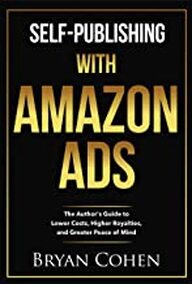|
Disclaimer: We are not connected with Bryan Cohen in any way and have no financial interest in his book. This review has not been paid for by Bryan Cohen or anyone else.  This book probably represents the best £3.99 I have ever spent since I started publishing. That is because it’s a book that actually paid for itself several times over. I would go so far as to say I wish I had read it 5 years ago, as it would have saved me a lot of time and money. That isn’t actually possible, as the book was only published this year, but you know what I mean. This article will be half book review and half blog. The blog part tells you what happened when we tried to apply the ideas and methods that Bryan Cohen recommends in “Self-Publishing With Amazon Ads”. Some of you may just want to know how that worked out, so that bit is at the end of the article. "You’ll have to find out the hard way that there is no such thing as “instant gratification” when it comes to marketing a book." If you are still reading this now, and haven’t scrolled down to find out what happened, you have one of the key qualities that Bryan Cohen talks about in the book: patience. Cohen doesn’t promise instant results. One of the first things you will learn from this book is that generating consistent results from Amazon advertising is a marathon not a sprint, and if you aren’t prepared to be patient then this may not be the book for you. You’ll have to find out the hard way that there is no such thing as “instant gratification” when it comes to marketing a book. If you have never used Amazon Ads, or you have only just dipped your toe in the water, then you will be at a bit of a disadvantage, as Cohen assumes some prior knowledge. But don’t worry. That prior knowledge is available. Amazon Ads provides webinars for its new users here. "helping authors to reduce the amount of money they spend while also getting better results" A word of caution about the webinar. It is aimed at encouraging you to spend money with Amazon Ads. After all, Amazon Ads is a business and it makes its profits from its users, so the more money users spend with them, the more profit Amazon makes. Bryan Cohen’s book, however, is aimed at helping authors to reduce the amount of money they spend while also getting better results. This means that some of Cohen’s advice on bidding strategies contradicts that of the webinar. And if you are wondering what a bidding strategy is, it means that you need to do the webinar before you dive into this book. Just a quick word about the author. He is a self-published author himself and he also provides self-publishing training and other services for authors through his website Best Page Forward. But not all the training he provides has to be paid for. Each quarter he hosts the 5 Day Amazon Ads Profit Challenge, which is free to join and which has provided coaching for over 25,000 authors. "She challenges Cohen at every turn" Each chapter in the book takes the reader through a different phase of a process that starts with poorly performing ads and progresses to turning those ads into high performing ones. Each chapter therefore introduces a new idea or method, so if you try to skip ahead to the “good bit”, where you are making millions, you are likely to miss out on a vital step which means your objective won’t be realised. See, once again you have to be patient. Just something to note. Early in the book Cohen talks about creating 5-10 ads a week. This is for the benefit of American readers, because Amazon.com allows readers to create customised ads and advertisers are encouraged to create several different customised ads a week to appeal to different segments of the market. That facility doesn’t exist for users of other Amazon markets (yet). For us, the Amazon page for our book is our ad. That is actually a timesaver for us, because one ad can run forever. However, the rest of what Bryan talks about is completely valid and if we ever get access to the customisation function, we'll be ready for it because we've read this book. Each chapter is broken down into two parts. One part is a “fly-on-the-wall” view of an on-line coaching session with one of Bryan’s clients, a woman called Erin. The other part is Bryan speaking directly to the reader to explain what he is teaching Erin. I don’t know if Erin is a real person or a composite character created for the reader’s benefit, but she is the person who asks the questions that the reader might want to ask. She comes to the course as a sceptic and has to be shown that the process works by actually implementing the methods herself so that she can see the profits from her ads increasing over time. And Erin isn’t a passive student. She challenges Cohen at every turn, especially on the issue of how long it will take to see returns and how she is going to fit in the time to do what he recommends. Because, as with all things, time is one of the most valuable resources we have and, as writers, we’d rather be spending our time writing than marketing. But Cohen is ahead of Erin here as well and there are specific sections on time management. "only a handful of people will ever achieve 6 digit profits" One of the things I liked about the book is that it is grounded in realism. When Cohen talks about increasing royalties and profits (not the same thing, as you will find out if you buy the book), he doesn’t promise telephone number sized amounts of money. He talks about investing $50 dollar a month to make $100 profit, which gives a feeling of being achievable. He then talks about increasing that profit to $200, $500 and maybe $1,000. He does refer to people who have made considerably more, but he tempers that with the realism that maybe only a handful of people will ever achieve 6 digit profits – but you get a warm feeling from knowing that, by doing a bit of work, you could be in that handful. Cohen is just as realistic about how much time we have available to do the work. He knows we have day jobs, families to look after and writing careers to pursue, so he tries to optimise the amount of work we may have to do in order to make best use of the time we have available. Time management is a key message. Readers of this blog will notice that I have only given the book 4 stars and therefore I had some reservations about it. That is true, but the reservations aren’t about the lessons that Cohen teaches, they are more about the way they are presented. For a start, Cohen refers to some calculations you may want to do in order to produce some performance data. Some worked examples would be very helpful to understand what he is talking about, but they are lacking. "bombarded with a whole lot of data" There are no handy graphics, such as screen shots of Amazon Ads pages, where things can be pointed out. While I am quite good with the internet, there are features I miss on web pages and some key features aren’t always the most prominently displayed. A graphic pointing out “This is the button you need to click” and “This is where you have to alter x” would be really helpful. The other thing I had a problem with is the additional applications that you might want to use, especially those relating to generating lists of keywords (If you don’t know what a keyword is, then see above regarding the Amazon Ads webinar). One of the applications has to be purchased (about £100) and comes with its own training videos, so that’s OK (it isn’t essential and you don’t have to buy it, but it is a useful tool and we will review it next week). But the other two are plug ins for Google Chrome, which are free and come with neither a user guide nor helpful training videos. I tried using them and was bombarded with a whole lot of data which I struggled to interpret. Some guidance on how to interpret the data produced by those plug-ins (with accompanying graphics), so that I could use it in ads, would have been really useful. But don’t let those three things put you off buying this book. Firstly, with a bit of patience (again) I found the buttons I needed to click and the things I needed to adjust. And, with some trial and error, I did work out how to interpret the data produced by the plug-ins. But it took time that I hadn’t factored in and which I had to divert from other activities. "while we were doing a lot of things right, we were also doing quite a few things wrong" So, how did we get on? The first thing you need to know is that here at Selfishgenie we aren’t complete novices. We have been running Amazon Ads for many years, with mixed results. From articles I had read on various websites I found out that advertising with Amazon wasn’t a quick fix. We would need to spend more money than we had in the past and let our ads run for longer if we wanted them to be successful. So, around April 2022 (before we bought this book) we decided to commit some of our sales revenue to improving our advertising, as an investment to make more revenue in the future. And it worked. We launched an ad campaign for our Carter’s Commandos series and saw our monthly royalties increase from the low three digit level per month to a four digit level by October, which we were able to maintain. But the amount of money we were spending to get that revenue seemed to be higher than it needed to be. In terms of profit on the campaign (the net amount we made from each sale compared to the gross amount we spent), we felt sure we should be doing better. That was when I stumbled across Bryan Cohen’s book. Actually, I did a search looking for blogs about using Amazon Ads and it appeared in the search results. It didn’t take long to discover that while we were doing a lot of things right, we were also doing quite a few things wrong. In particular, our bidding strategy was wrong. We thought we could buy sales by spending more money. In fact, all we were doing was giving Amazon more money than we needed to, which was reducing the profit from the sales we did make. "give away Bryan’s secrets for free" The way Amazon’s advertising algorithms work mean that bid price is only one factor in getting our ads seen. I won’t steal Bryan Cohen’s thunder (or reduce his books sales) by telling you what the other variables in the algorithms are. (I know, but it wouldn’t be fair to give away Bryan’s secrets for free). I won’t bore you with all the details of what we did. Suffice to say that we learnt the lessons that Bryan Cohen was trying to teach us.  But what we did do was to run a trial to see how his methods compared to our own. We continued to advertise our Carter’s Commandos series the way we always had. But our Magi sci-fi series had been bumping along the bottom, making very few sales per month. So, we started a brand new ad campaign for the first book in that series and applied the newly learnt lessons to that series to see what happened. NB. When I refer to "sales" below I also mean KindleUnlimited (KENP) pages read. 1st 30 Days The good news is that we got clicks on our ads from Day 1 and we made more sales than in the previous 3 months, but they weren’t Earth shatteringly good. The campaign wasn’t profitable, meaning we spent more than we received in Royalties. We tweaked the book’s blurb (see last week’s review of “Fiction Blurbs: The Best Page Forward Way”), but there wasn’t much else we could do to stimulate more sales during that period. 2nd 30 Days Here we started to reap the benefit of “delayed results”. It is said that buyers have to see an ad an average of 7 times before they respond. This seemed to be the case as the number of clicks on our ads increased the longer the ad ran and we started to see more sales. But we also started to see sales for books we hadn’t advertised. The Magi is a 9 book series, and we were only advertising Book 1. But we started to get sales for books 2 – 9, which we hadn’t advertised. Our original ad was instrumental in developing a “fan base” for the series. These additional sales meant we were now in profit. Final 30 days I’d be lying if I told you that sales really started to take off. But they did continue even if they were unspectacular. There seems to be some sales resistance to The Magi series which we aren’t getting for other series, and we need to dig into that to see if we can work out what is causing it. The final 30 days of the trial was also during January, when money is traditionally tight for people - even avid readers of sci-fi. However, we have sold more copies of titles in The Magi series in the last 90 days than we did in the previous 9 months and the campaign is showing a profit, so overall we count it as a success. "highly recommended" So, what are the main take-aways we have from the book? 1. This isn’t a quick fix. We required patience and strong nerves to spend money without seeing a profit for several weeks. 2. If we are doing a “category ad” (advertising by genre), we needed to keep the band narrow so as not to waste money on genres that aren’t relevant and where our ad may generate a click (which we pay for) but won’t get converted into a sale. 3. We needed to use more keywords in our ads and we had to make them relevant to the genre of books we were selling. The Magi series is “space opera”, so there is no point in using keywords that relate to dystopian sci-fi. Again, they may generate clicks, but they won’t get converted into sales. 4. We needed to use the data from the ad campaigns to help reduce our costs. For example, we were getting hundreds of clicks for one keyword, generating cost, but the clicks didn’t convert to sales. Conclusion: readers who use that keyword aren’t interested in our book. So, we deleted the keyword from the list. 5. It works!  Having learnt from this experience, we have now tweaked our ad for Carter's Commandos, to take into account what we now know we can do better, which hasn't increased our sales but has reduced our costs, so we are actually keeping more of our money, which is a win, which makes us happy. If you are an Indie author or a small publisher (like us) then “Self-Publishing With Amazon Ads” by Bryan Cohen is highly recommended. To find out more about the book, just click or tap on the cover image at the top of the blog. If you have enjoyed this blog, or found it informative, then make sure you don’t miss future editions. Just click on the button below to sign up for our newsletter. We’ll even send you a free ebook for doing so.
0 Comments
Leave a Reply. |
AuthorThis blog is compiled and curated by the Selfishgenie publishing team. Archives
March 2025
|

 RSS Feed
RSS Feed